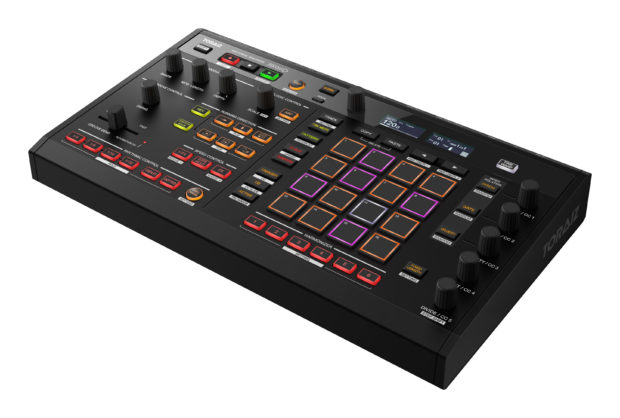From Pioneer US HQ in TORRANCE, CA, April 24, 2019:
Take control of your workflow and make new styles of music with the SQUIDTM. Named for the blend of functionality and creative stimulation it offers, the SQUID (SeQUencer Inspirational Device) is a brand-new multitrack sequencer in Pioneer’s TORAIZTM series of musical instruments and production gear. Connect all your instruments to use the SQUID as the heartbeat of your studio and live setup, and get hands-on with innovative features never seen before on this kind of equipment.
It’s easy to start making unique sequence patterns and phrases as soon as you hook the SQUID up to your instruments. The layout of the controls is optimized so you can effortlessly bring your ideas to life whenever inspiration strikes, and the workflow is perfect for on-the-fly music production. All this means you can spend less time looking at the unit’s display and more time creating music.
With the first Groove Bend feature ever seen on a production tool,1you can really feel the groove and generate original rhythms in real time by simply moving the spring-loaded slider to change the trigger timing. UseRunning Direction to create different phrases by changing the playback direction of sequence patterns you’ve programmed on the 16 pads and fluctuate the playback speed of sequenceswhenever you want using Speed Modulation.All of these features contribute to a fresh, nonlinear way of making music that breeds creativity and helps you stumble across things that sound great.
When you’ve created a phrase you love, you can use the SQUID Manager to back it up, along with all your projects. SQUID Manager is a free dedicated application that enables you to quickly import/export sequence patternsbetween the SQUID and a PC/Mac.
Reaching out into your setup, the SQUID simultaneously controls up to 16 instruments with its master pulse. It keeps everything in sync, from your DAW to hardware instruments such as the TORAIZ AS-1 monophonic analog synthesizer and the TORAIZ SP-16 professional sampler. You can even run modular synths and vintage drum machines/synths seamlessly alongside your other kit.
The SQUID fits perfectly into any studio or live music environment and helps you turn your ideas into music. It’s the third product in the TORAIZ series, which offers inspiring tools with unique features you can easily use to create new sounds.
The TORAIZ SQUID will be available from end of April at an MAP of $599.
Watch the SQUID introduction video or, for a detailed look at each unique feature, watch our walk-through video. Find out more about the SQUID here.
Download Information
To use SQUID Manager, you’ll need to update to the latest firmware (ver. 1.10).
Download link:http://bit.ly/2vblHDm
KEY FEATURES OF THE TORAIZ SQUID
- Step Edit section for intuitively creating sequence patterns
Have fun creating phrases by tapping the 16 multicolored LED rubber pads. Set step parameters and play in real time as if the pads were keys on a keyboard, combining various sequence functions such as Interpolation and Harmonizer to help build your sounds.
- 16 multicolored LED pads for enabling various features
Instantly switch between features using the SQUID’s 16 multicolored LED rubber pads, which are linked to independent modes. Use Trigger mode to step-record sequence patterns, and transpose your patterns on the fly with Transpose mode. Scale mode enables you to play scales with the 16 pads as if you were playing a keyboard and you can add nuanced expression to your performances by varying the strength of your keystrokes, thanks to the high-precision velocity detection. Using Scale mode, you can also record dynamic performances in real time.
- Interpolation:instantly make a phrase
Use Interpolation to arrange phrases. Set each parameter (Pitch, Gate, and Velocity) for the beginning, middle, and the end of the steps, and the SQUID automatically interpolates (supplements) parameters for the steps in between them. Without needing to set the parameters of each step individually, you can quickly set the pitch and dynamics of the sound and create a phrase while the idea is fresh in your mind.
- Harmonizer: intuitively create evolving phrases
If you want inspiration for chords, Harmonizer enables you to play them easily by hitting the Harmonizer buttons with the Pitch value set on each step parameter as the root note. Up to six chords can be assigned to the Harmonizer buttons. You can record chord compositions into steps and record real-time performances with the Harmonizer buttons, so you can intuitively create evolving phrases.
- Phrase arrangement section for rearranging sequence patterns in real time
Use Running Direction, Speed Modulation, and Groove Bend to further rearrange phrases you’ve created in the Step Edit section. Each feature has an optimized user interface so you can intuitively try out ideas as they spring to mind.
- Speed Modulation: create unique grooves by fluctuating playback speed of sequence patterns
Periodically increase and decrease the playback speed of a sequence to create unique grooves. You can switch between six waveform shapes, such as triangle and sawtooth, and adjust the rate and amount.
- Running Direction: easily create new phrases
You can easily create multiple new phrases from one sequence pattern by changing its playback direction on the 16 pads. Try the Zigzag or Clockwise directions, which take advantage of the SQUID’s 4 x 4 pads – a unique feature never seen on a general sequencer before. By combining Reverse, Switch Back, and Flip with the six different Running Directions, you can try out 48 different playback directions and create a variety of different phrases.
- Groove Bend: change trigger timing in real time
In addition toSwing,which automatically delays trigger timing to create grooves, the SQUID features GrooveBend – the first-ever function on a sequencer to change trigger timing in real time via a slider. This enables you to create grooves as if you’re playing a musical instrument by simply moving the spring-loaded slider.
- Time Warp: save your “happy accidents”
Never lose the phrases you make incidentally when you’re trying things out. Use Time Warp to audition the previous phrase you created and save it as a new sequence pattern if you like it. There’s no need to stress over the workflow of practicing and recording take after take. Instead, feel free to just play around until you hear something you love, then capture it for use in a track or performance.
- Multiple inputs/outputs: sync with various instruments
In addition to a USB B terminal and Midi terminals for your DAW and hardware synthesizers, you can sync and play with modular synthesizers using the two sets of CV/GATE outputs and CLOCK input/output terminals. DIN SYNC input/output terminals enable syncing with vintage synthesizers and drum machines. Various signals including notes and clocks are mutually converted inside the SQUID automatically, so you can easily expand your creative scope just by adding the SQUID to your current setup.
- Import/export sequence patterns via PC/Mac
Using the SQUID’s dedicated SQUID Manager, you can quickly import and export sequence patterns between the SQUID and your PC/Mac. Easily import a sequence pattern created on your DAW to the SQUID, intuitively arrange it using the sequencer’s features, and return it to your DAW. Use SQUID Manager to back up the projects you create on the SQUID by saving them to your PC/Mac.
1 First slider-operated trigger timing feature in the music production category (according to research conducted by Pioneer DJ Corporation, as of April 18,2019).
TORAIZ SQUID Specifications
| Maximum number of tracks | 16 tracks | |
| Maximum number of patterns per track | 64 patterns | |
| Maximum number of steps per track | 64 steps | |
| Step resolution | Quarter note, Eighth note, Sixteenth note, Twenty-fourth note, Thirty-second note | |
| Maximum number of notes per step (polyphony) | 8 notes | |
| Maximum number of projects | 128 projects | |
| Input / Output Terminals | MIDI | MIDI IN MIDI OUT 1 MIDI THRU / OUT 2 |
| USB | USB (Type B) | |
| CV / GATE | CV OUT 1, CV OUT 2 (V/Oct, Hz/V)
GATE OUT 1, GATE OUT 2 (V-Trigger, S-Trigger) |
|
| CLOCK | CLOCK IN (step, 1, 2, 4, 24, 48ppqn, Gate)
CLOCK OUT (1, 2, 4, 24, 48ppqn) |
|
| DIN SYNC | DIN SYNC IN / OUT 2 (24, 48ppqn)
DIN SYNC OUT 1 (24, 48ppqn) |
|
| Maximum dimensions (W x D x H) | 374.8 × 223.9 × 72.1 mm / 14.8” x 8.8” x 2.8” | |
| Weight | 1.9 kg / 4.2 lb | |
| Accessories | AC adaptor, Power cord, Quick Start Guide | |
SQUID Manager Requirements
| Mac | macOS Mojave 10.14 (Updated to the latest version)
macOS High Sierra 10.13 (Updated to the latest version) |
| Windows | Windows® 10, 8.1, 7 (The latest service pack) |
| CPU | Intel® processor Core™ i7, i5, i3 |
| Memory | 4GB or more |
* Disclaimer: specifications and price are subject to change.
* TORAIZ is a registered trademark or trademark of Pioneer DJ Corporation, Japan and United States, and other countries.
* SQUID is a trademark of Pioneer DJ Corporation, Japan and United States, and other countries.
* Mac, OS X and macOS are trademarks of Apple Inc., registered in the U.S. and other countries.
*Windows is a registered trademark or trademark of Microsoft Corporation in the U.S. and other countries.
* Intel and Intel Core are registered trademarks of Intel Corporation in the U.S. and other countries.
* The names of companies, product names, and technology names mentioned herein are the trademarks of their respective owners.





